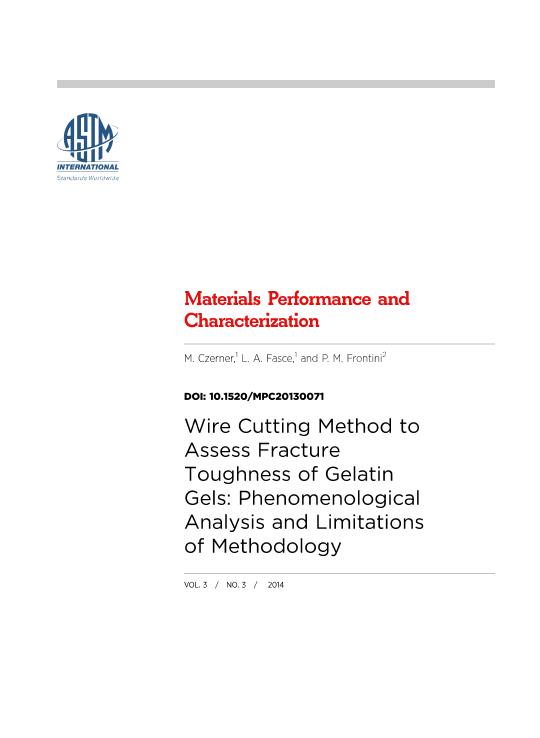Mostrar el registro sencillo del ítem
dc.contributor.author
Czerner, Marina

dc.contributor.author
Fasce, Laura Alejandra

dc.contributor.author
Frontini, Patricia Maria

dc.date.available
2016-04-07T15:18:22Z
dc.date.issued
2014-01-17
dc.identifier.citation
Czerner, Marina; Fasce, Laura Alejandra; Frontini, Patricia Maria; Wire cutting method to assess fracture toughness of gelatin gels: Phenomenological analysis and limitations of methodology; ASTM International; Materials Performance and Characterization; 3; 3; 17-1-2014; 448-468
dc.identifier.issn
2165-3992
dc.identifier.uri
http://hdl.handle.net/11336/5054
dc.description.abstract
In this work the performance of the wire cutting method for determining the fracture toughness, Gc, of gelatin hydrogels is assessed. In this method, wires of different diameters are pushed into a sample while the force and displacement are continuously recorded. The cutting action reaches a steady state, in which fracture propagation, deformation, and friction occur simultaneously. The method implies a linear relationship between the steady-state cutting force per unit sample width and the wire diameter, of which the y-intercept is Gc. Several gel samples differing in gelatin concentration, source (bovine or porcine), solvent (water or water–glycerol mixture), and crosslink type (physical or chemical induced by glutaraldehyde) were tested at different rates. Post-mortem fracture surfaces examined via optical microscopy displayed four different morphologies depending on the gel formulation, cutting rate, and wire diameter: I, striated; II, with one or two oblique straight lines; III, with rhombus-like figures; and IV, with material pull-out. A direct relationship between the developed fracture surface morphology and the method performance existed. One necessary condition for obtaining the linear relationship is a unique fracture surface morphology remaining for all of the wires utilized in the determination. The method is invalid if the fracture surface morphology changes with changing wire diameter, abnormal crack path deflection takes place, or material pull-out occurs as a result of adhesion effects. The applicability of the method seems to be not constrained to physical gels. An appropriate cutting rate and wire diameter have to be selected in order for a unique fracture surface morphology to be achieved. In such cases, reasonable Gc values were obtained from the y-intercept of the best linear fit of experimental data. Gc increased with increasing gelatin concentration, Bloom number, and solvent viscosity. Moreover, Gc was greater when a rhombus-like pattern was induced rather than other morphology due to greater crack path tortuosity.
dc.format
application/pdf
dc.language.iso
eng
dc.publisher
ASTM International
dc.rights
info:eu-repo/semantics/openAccess
dc.rights.uri
https://creativecommons.org/licenses/by-nc-sa/2.5/ar/
dc.subject
Soft Materials
dc.subject
Gelatin Gels
dc.subject
Wire Cutting Method
dc.subject
Fracture Toughness
dc.subject.classification
Ingeniería de los Materiales

dc.subject.classification
Ingeniería de los Materiales

dc.subject.classification
INGENIERÍAS Y TECNOLOGÍAS

dc.title
Wire cutting method to assess fracture toughness of gelatin gels: Phenomenological analysis and limitations of methodology
dc.type
info:eu-repo/semantics/article
dc.type
info:ar-repo/semantics/artículo
dc.type
info:eu-repo/semantics/publishedVersion
dc.date.updated
2016-05-06 15:52:43.262787-03
dc.journal.volume
3
dc.journal.number
3
dc.journal.pagination
448-468
dc.journal.pais
Estados Unidos

dc.journal.ciudad
West Conshohocken
dc.description.fil
Fil: Czerner, Marina. Consejo Nacional de Investigaciones Científicas y Técnicas. Centro Científico Tecnológico Mar del Plata. Instituto de Investigación En Ciencia y Tecnología de Materiales (i); Argentina. Universidad Nacional de Mar del Plata. Facultad de Ingeniería; Argentina
dc.description.fil
Fil: Fasce, Laura Alejandra. Consejo Nacional de Investigaciones Científicas y Técnicas. Centro Científico Tecnológico Mar del Plata. Instituto de Investigación En Ciencia y Tecnología de Materiales (i); Argentina. Universidad Nacional de Mar del Plata. Facultad de Ingeniería; Argentina
dc.description.fil
Fil: Frontini, Patricia Maria. Consejo Nacional de Investigaciones Científicas y Técnicas. Centro Científico Tecnológico Mar del Plata. Instituto de Investigación En Ciencia y Tecnología de Materiales (i); Argentina. Universidad Nacional de Mar del Plata. Facultad de Ingeniería; Argentina
dc.journal.title
Materials Performance and Characterization
dc.relation.alternativeid
info:eu-repo/semantics/altIdentifier/url/http://www.astm.org/DIGITAL_LIBRARY/JOURNALS/MPC/PAGES/MPC20130071.htm
dc.relation.alternativeid
info:eu-repo/semantics/altIdentifier/isbn/2165-3992
dc.relation.alternativeid
info:eu-repo/semantics/altIdentifier/doi/http://dx.doi.org/10.1520/MPC20130071
Archivos asociados
